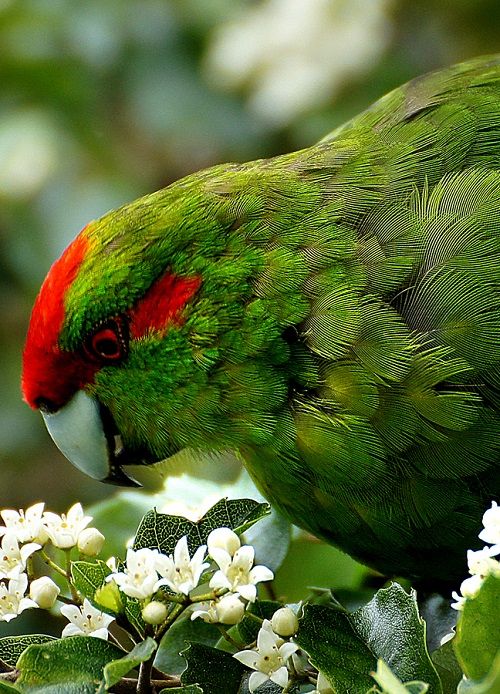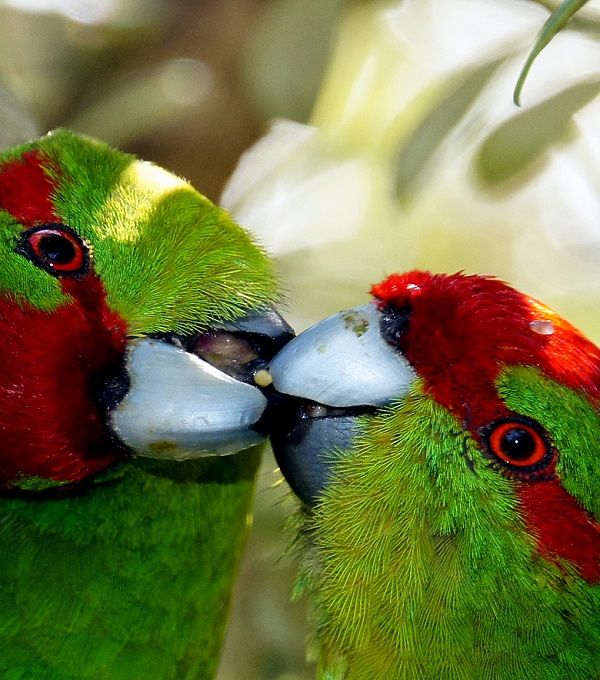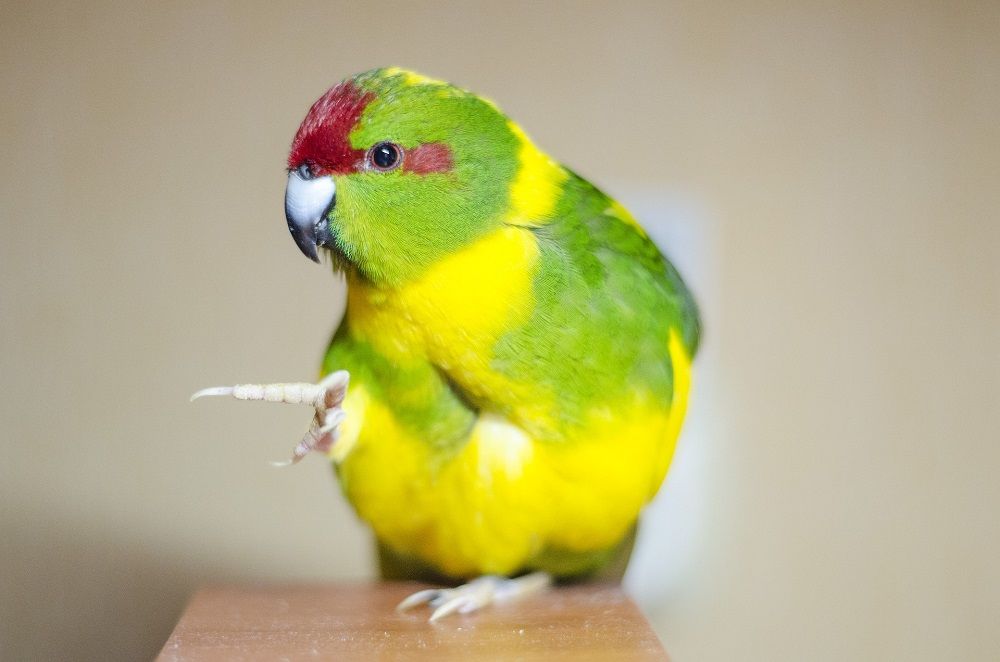If you’re thinking of adding a kakariki to your family, you may be wondering how long they live. What can you expect in terms of kakariki lifespan? Do they live as long as other parrots, which can be around for decades?
Let’s have a look at all the ins and outs of kakariki lifespan for the different subspecies of this New Zealand native!
This post contains affiliate links. If you make a purchase, a small percentage will go directly to Psittacology at no additional cost to you. Thank you for supporting Psittacology!
Kakariki lifespan in the wild
If you were interested in finding out more about how long kakarikis live in the wild, I’ve unfortunately got bad news. As with many other parrot species, wild kakariki lifespan hasn’t been extensively studied. That’s not surprising: these guys can be quite elusive in their natural habitats.
I suppose tagging and tracking birds living inside protected zones would provide some insight into how long they live, but from scouring scientific records, I’ve concluded that no one has tried that yet as far as I could find.
One study mentions “(…) little is known about any patterns of reproductive senescence [aging] or even their average lifespan in the wild, although it is thought they are short-lived for parrots” (Irwin, 2017).

Kakariki lifespan in captivity
When it comes to kakarikis in captivity, there is a bit more information available to help us figure out how long they can be expected to live. This info does kind of confirm what was mentioned in the previous paragraph: kakarikis aren’t nearly as long-lived as some other parrot species like cockatoos. Still, the numbers seem pretty normal for a small parakeet.
As with the majority of other parrot lifespan articles on Psittacology, I mainly relied on a 2012 study called Survival on the Ark for this. This is one of the most comprehensive papers that can be found on parrot lifespan, but it’s important to keep in mind that it deals with birds in zoos, not homes. Still, it gives us somewhat of an idea that isn’t just based on anecdotes.
Unfortunately not all kakariki species are included, but the most popular one (the red-crowned kakariki, Cyanoramphus novaezelandiae) is. Here are the numbers I could find for kakariki lifespan:
| Name (common, scientific) | Maximum recorded lifespan (rounded) | Median lifespan (rounded)* |
| Red-crowned parakeet, Cyanoramphus novaezelandiae | 36 | 7 |
| Yellow-crowned parakeet, Cyanoramphus auriceps | 16 | 6.5 |
| Orange-fronted parakeet, Cyanoramphus malherbi** | 12 | 7.5 |
| Antipodes parakeet, Cyanoramphus unicolor | 12.5 | 6.5 |
Another study, which was published in 2000, lists records for Cyanoramphus novaezelandiae and auriceps, respectively. The ages recorded here are 12.5 and 9.5.
What we can conclude from this is that kakarikis tend to live between 5-15 years, although it’s not out of the question for one to make it to 20 or up either.
What influences kakariki lifespan?
So what can you do if you want your kakariki to live a long and happy life? Maybe even make it to 36, like the longest-lived individual in the table above? The unfortunate truth is that the majority of parrots in captivity don’t make it anywhere close to their potential lifespan due to not being cared for properly.
Some common (and preventable!) issues that plague pet parrots and cause their premature deaths include:
- Bad diet (leads to malnutrition, obesity)
- Not let out of their cage (leads to obesity and muscle deterioration)
- Stress (left alone, bored, no toys)
- Ignorance of birds’ sensitivity (smoking indoors, perfumes and the like cause respiratory disease and even death)
- Accidents due to preventable safety issues (allowing the parrot to interact with other pets, open windows and doors)
- Owners hesitant to visit a vet due to the cost (which can lead to curable issues becoming deadly)
You’ll want to prevent all this and more if you’d like to give your kakariki the chance of living a long life. I’ll lay out some basic tips below, but don’t forget to also have a look at the more detailed full kakariki care guide!

Care tips for a long life
Although some parrots just don’t win the genetic lottery and are bound to pass away prematurely due to disease, there’s a lot that you can influence.
For a happy, healthy and long-lived kakariki, don’t forget the following:
- Diet: Parrots should be fed a high-quality staple pellet as a base diet, supplemented with plenty of fresh veggies and some fresh fruit. Variety is key here! You can read more in the article on parrot diet.
- Housing: Your kakariki needs a full-sized aviary if you’re not planning on letting it fly free. If it will spend most of its day roaming free, you can go for something of at least 60 x 45 x 45 cm (24 x 18 x 18″), although bigger is always better.
- Socialization: Like all parrots, kakarikis are extremely social creatures. If you can’t provide yours with multiple hours of attention daily, you need to get it a friend. The stress of being left alone can likely take years off a parrot’s life.
- Enrichment: Parrots need to use their smart brains to explore new things and even figure out easy puzzles in order to stay entertained and stress-free. They just get bored without parrot toys, exploration, a varied diet and other enrichment options.
- Safety: Read up on parrot safety, because these birds are very fragile. For example, did you know the fumes from non-stick appliances can kill them? Any room your kakariki has access to needs to be bird-proofed. And have the number for an avian vet ready at all times!
Kakariki Care, Diet, Housing & More | A Cheerful Pet Parakeet
Thinking of adding a kakariki parakeet to your feathered family? Good choice! These delightful New Zealand natives can make fantastic, loving pets. But what does …
Read More
How old is my kakariki?
If you got your kakariki from a breeder, they should be able to tell you all about when your bird hatched. Even if you can’t get in touch with them, your parrot may have a leg band that states its birth year. But what if you bought your kakariki in a pet store that has no idea, or if it was a rescue?
It’s understandable to want to know how old your pet is, just to know how much longer you can expect it to be around for, and so it’s clear whether certain issues that may pop up can be attributed to age. Older parrots often need some extra care.
The annoying thing is… there’s no way to know. Past about the two month mark, when a baby kakariki’s feathers have fully grown in, there are no visual markers that betray its age. In younger birds, you’ll see developing pinfeathers, duller colors and a less pronounced head cap.
If you have any more questions about kakariki lifespan or if you’d like to share your own experiences with these colorful parakeets, don’t hesitate to leave a comment below!


I’ve bred red-fronted kakarikis for many years in Australia, with most of my birds being cinnamon, normal-pied and cinnamon-pied. The average (adult) lifespan of my birds was 10-12 years, with the oldest living to almost exactly 14 years (about a week over). All were aviary bred, but came inside as free-flighted house birds at the end of their breeding lives (7+ years). Diets included lots of green seeding grass, veggies, some fruit and a little animal protein on a regular basis, supplemented with a small parrot seed mix. One of my favourite birds of all time.
Thank you for sharing, that’s very helpful! They really are amazing little birds.
We welcomed our kakariki into our home two years ago. What a character she is. Full of fun you can’t help but love her and hilarious as she scuttles across the floor like a wind up toy. Only one problem persists and that’s the fact she thinks she’s a chicken.
We’ve tried every piece of advice we’ve found online. Replaced her eggs with imitation ones. Removed mirrors. Stopped stroking her. Left her for three or four weeks to sit on them in the hope she’ll realise they’re not fertile. Shortened her days by covering her cage.
Nothing seems to stop her. For a week or so after her eggs are gone she will return to being a lovable wee bird, full of fun. She will then do her “beep beep” dance with her rear in the air, then a few days later, another egg with five a usual maximum.
So the question is? Is there anything we can do to reduce her egg production. She seems healthy enough. No eggs full of fun and interaction. With eggs grumpy and cantankerous.
She’s turned my books into confetti and started stripping wallpaper from our walls. At first I got frustrated but she’s just so damned loveable I now just shrug my shoulders. That’s how great these little birds are.
Ack! Yeah, this is a common issue with parrots, as I’m sure you’ve found out by now. I’ve got plenty of advice to give on the topic, but it looks like you’ve been through the works already trying all the different solutions. The egg laying is hard on their body, so definitely feed plenty of calcium if you weren’t doing so already. The last thing to try for many parrot owner is birdie birth control shots that make them less hormonal, but you would have to discuss this with your avian vet – I don’t have personal experience with it. If you haven’t asked a vet already, I’d definitely recommend that as a next step anyway.
Good luck, I hope you guys can get your chicken to realize she’s a kakariki! She sounds like a fantastic little bird in any case. 🙂
Helo every one .. I’ve found the same bird but dont what he eats can someone tell me please
Hey! Check out the full kakariki care guide, it contains everything you need to know about these parrots 🙂 good luck!